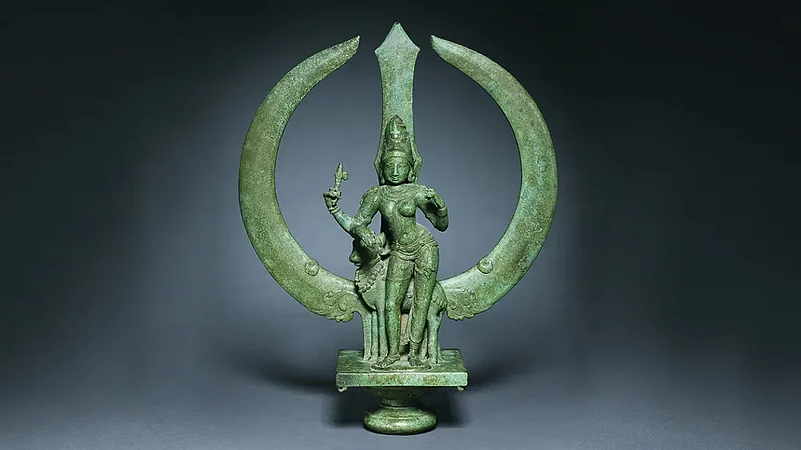The Supreme Court, through its recent observation about the need to provide “social welfare legislation” to “atypical manifestations of the family unit”, and by underlining that the LGBTQIA+ community is “equally deserving” of all legal protections, reflected the ancient Indian wisdom that had created the space for such relationships. It might have taken queer activists several decades to see Section 377 decriminalise, but the LGBTQIA+ is hardly a taboo in ancient Indian scriptures.
Perhaps, the foundation head of such description is Ardhanarishvara, the merger of a male and a female deity as embodied by Shiva and Parvati. By lending an androgynous character to the Supreme Being, the ancient texts subverted the idea of rigid gender roles dominating the modern world centuries later. But this is not the only instance of subversion. Unlike the present times when movies about queer relationships often become controversial or invoke hush conversations, Sanskrit texts are replete with characters having varied and unfettered sexuality. While the movie Fire (1996) that showed a romance between two women drew the outrage of Hindu groups, sculptures in several temples, as well as excerpts in the Kamasutra, talk about such love in great depth.
“There were eight different types of marriage according to the Vedic system, and homosexual marriage that occurred between gays or lesbians, was classified under the gandharva or celestial variety,” writes Amara Das Wilhem in Tritiya-Prakriti: People of the Third Sex: Understanding Homosexuality, Transgender Identity and Intersex Conditions Through Hinduism. One can easily read the echo of the SC’s observations in these words. Wilhem underlines that ancient Vedic culture did not punish or attempt to correct homosexuals or the third sex, but gracefully accepted their nature. The homophobia and transphobia that one witnesses now is hardly present in Hindu myths. The third gender was termed tritiya prakriti and enjoyed several rights.
As late as in the 16th century, Lord Ram asserts in the holy text Ramcharitmanas that whosoever worships him is dear to him, whether they are “purush, napunsak, nari, va jiva, charachar koi (male, queers, women, and all the beings of the world).” The utterance of the word “napunsak” by the most stoic of the Lords must not surprise anyone, because perhaps all the modern categories of lesbian, gay, bisexual, transgender, transvestite and gender fluidity recur in old texts. Lending credence to such behaviour are numerous deities who freely change their gender, live a new life and perform several functions, mostly sexual, and even occasionally switch back to their previous form. In a famous tale, Lord Vishnu takes the form of Mohini and seduces Shiva. Their reunion leads to the birth of Ayyappa, one of the most famous deities in southern India. Few objected to such representations of deities as these tales prevailed for centuries.
During their last year of exile when the Pandavas were required to turn incognito, the great archer Arjuna dresses up in a woman’s attire and assumes the name Brihannala to secure an entry into the king’s palace and teach dance and music to his daughter Uttara. It is one of the greatest instances of transvestite behaviour by a major character in an Indian epic. The Mahabharata also has a character Shikhandi, who was born female, but later changed gender, and eventually caused the death of Bhishma in the war.
Ancient Hindu texts celebrate life in various forms and do not seem to attach any stigma to same-sex romances, which the Indian Penal Code crudely and unjustly termed “unnatural offence”. Notably, the legitimacy of such behaviour is not derived from descriptions in the Charvaka or the materialistic and heterodox school of philosophy. It rests on the wisdom strewn across the orthodox school of thought and holy texts that have numerous nomenclatures to describe gender behaviour that would now be termed non-binary. Some texts occasionally mention a mild displeasure over sexual acts between such persons, but it does not entail the social boycott one gets to see in the modern era.
The tales and characters mentioned in these texts were also carved in temples across the country, with the famous Khajuraho being one of the many. These vivid images could not have been the wild fantasies of sculptors, but perhaps reflected the customs and practices of several sections of society. Monuments like the Konark Sun Temple, now a UNESCO heritage site, were built under the watchful eye of successive kings and their courts.
There’s also a rich tradition of male poets worshipping deities, like a woman pining for her lover—a form that was most prevalent during the Bhakti era in various parts of the country, from Tamil Nadu to Uttar Pradesh. Nammalvar wrote love songs for Lord Vishnu, Surdas composed poetry for Krishna and then there was the mystic poet Kabir, who famously said: “Hari mera piyu, main hari ki bahuriya (Lord Ram is my husband, I am his wife).”
It can be seen as a mystic expression, but one can note that it belonged to an era when the language—the site that perpetuates the earliest injustice—was fluid enough to allow people to express themselves in a different gender. An era that didn’t enforce rigid distinctions instead accommodated ambivalent identities and manifestations. A number of queer activists often invoke old Indian texts to point at the fallacy of the modern legal and social systems that stigmatised their life.
But descriptions also had a profound metaphysical foundation. It reflected a society that was infinitely more inclusive of diverse thoughts, a civilisation that was founded on the ideal of Advaita or non-dualism, a culture that emphasised on Tat Twam Asi or That Art Thou, signifying that every being is, in essence, the Ultimate Reality. It also mirrored the truth about swa-dharma, a duty that one must perform in order to realise one’s true self. In a famous tale, a scorpion repeatedly stings a sage who tries to rescue him. When asked why he saves a creature that stings him, the sage replies, “The scorpion is performing his swa-dharma, so am I.” Effectively, everyone is duty-bound to fulfil their dharma. The Gita says this emphatically in Chapter Three, when it advises that “it is far better to perform one’s swa-dharma, though tinged with faults, than to perform another’s prescribed duty, though perfectly.”
As the focus shifted from swa-dharma to a uniform moral code in the modern era, one was forced to surrender one’s desires to the public conscience. The LGBTQIA+ activism, thus, is also an attempt to assert swa-dharma.
(This appeared in the print edition as "As Old as Time")


























